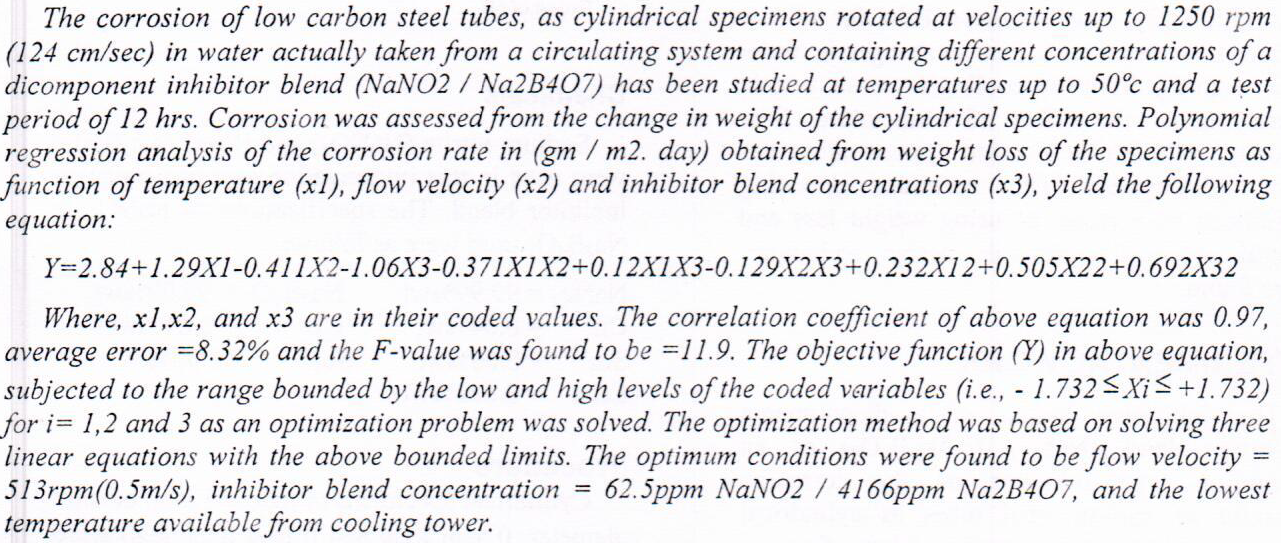
Aeromonas hydrophila have been isolated as a cause of a cute gastroenteritis in 23 (5.6%) of 410 patients. Other bacterial enteropathogens have been isolated from 387 patients with diarrhea, were 19 different strains. A. hydrophila occurred more commonly in children with acute diarrhea, the results showed that 18(78.26%) isolates of A. hydrophila found in children under 10 years old ,distributed to 10(43.47%) in male and 8(34.78%) in female ,and in adults with diarrhea 5 (21.73%). In the other hand, we noticed frequency of isolation was higher in male 14(60.86%) when compared with 9(39.14%) in female. Six strains of A. hydrophila have been observed to have bacteriocin activity against 12 of 23 different A. hydrophila ,as well as Staphy
... Show MoreIn this article the unsteady magnetohydrodynamics oscillating flow of third order fluid with free stream velocity is proposed. It is found that the motion equation is controlled by five dimensionless parameters namely the coecostic parameter 4, viscoelostic parameter ?,acceleration/deceleration c,suction/blowing d and material constants ? . The effect of each of these parameters upon the velocity distribution is analysised
Radiotherapy is medical use of ionizing radiation, and commonly applied to the cancerous tumor because of its ability to control cell growth. The amount of radiation used in photon radiation therapy called dose (measured in grey unit), which depend on the type and stage of cancer being treated. In our work, we studied the dose distribution given to the tumor at different depths (zero-20 cm) treated with different field size (4×4- 23×23 cm). Results show that the deeper treated area has less dose rate at the same beam quality and quantity. Also it has been noted increasing in the field increasing in the depth dose at the same depth even if the radiation energy is constant. Increasing in radiation dose attributed to the scattere
... Show MoreThe purpose of this research is to investigate the impact of corrosive environment (corrosive ferric chloride of 1, 2, 5, 6% wt. at room temperature), immersion period of (48, 72, 96, 120, 144 hours), and surface roughness on pitting corrosion characteristics and use the data to build an artificial neural network and test its ability to predict the depth and intensity of pitting corrosion in a variety of conditions. Pit density and depth were calculated using a pitting corrosion test on carbon steel (C-4130). Pitting corrosion experimental tests were used to develop artificial neural network (ANN) models for predicting pitting corrosion characteristics. It was found that artificial neural network models were shown to be
... Show MoreMolecular dynamics (MD) simulations were carried out in order to investigate the binding mode of axillaridine-A at the active site of human acetylcholinesterase (AChE) enzyme. 2.0 nanosecond of MD simulations was made for the protein and the complex to dynamically explore the active site and the behavior of the ligand at the peripheral AChE binding site. These calculations for the enzyme alone showed that the active site of AChE is located at the bottom of a deep and narrow cavity whose surface is lined with rings of aromatic residues and Tyr72 is almost perpendicular to the Trp286 ring and forms a stable - interaction. The size of the active site of the complex decreases with time due to increase the interaction. Axillaridine-A forms
... Show MoreBackground: Hypertension is a major global health concern that increases the risk of cardiovascular disease. Understanding the impact of age and treatment types on blood pressure control is essential for optimizing therapeutic strategies. Aim: This study aims to assess how different treatment types and patient age influence blood pressure control in hypertensive patients. Methodology: A binary logistic regression model was employed to analyze data from 48 patients diagnosed with hypertension. The study investigated the impact of two treatment regimens and patient age on the likelihood of achieving optimal blood pressure levels. The statistical significance of the findings was evaluated using chi-square tests and p-values. Results: T
... Show MoreChitosan (CH) / Poly (1-vinylpyrrolidone-co-vinyl acetate) (PVP-co-VAc) blend (1:1) and nanocomposites reinforced with CaCO3 nanoparticles were prepared by solution casting method. FTIR analysis, tensile strength, Elongation, Young modulus, Thermal conductivity, water absorption and Antibacterial properties were studied for blend and nanocomposites. The tensile results show that the tensile strength and Young’s modulus of the nanocomposites were enhanced compared with polymer blend [CH/(PVP-co-VAc)] film. The mechanical properties of the polymer blend were improved by the addition of CaCO3 with significant increases in Young’s modulus (from 1787 MPa to ~7238 MPa) and tensile strength (from 47.87 MPa to 79.75 MPa). Strong interfacial
... Show MoreObjectives: To review the failure rates of molar tubes and the effect of molar tube base design, adhesive type, and bonding technique on the failure rates of molar tubes. Data: The revolution of molar bonding greatly impacted fixed orthodontic appliance treatment by reducing chair-side time and improving patient comfort. Even with the many advantages of molar bonding, clinicians sometimes hesitate to use molar tubes due to their failure rates. Sources: Internet sources, such as Pubmed and Google Scholar. Study selection: studies testing the bond failure rate of molar tubes. Conclusions: The failure rate of the molar tubes can be reduced and the bond strength of the molar tubes can be improved by changing the design of the molar tube base
... Show More (3)
(3)
 (2)
(2)
In the recent decade, injection of nanoparticles (NPs) into underground formation as liquid nanodispersions has been suggested as a smart alternative for conventional methods in tertiary oil recovery projects from mature oil reservoirs. Such reservoirs, however, are strong candidates for carbon geo-sequestration (CGS) projects, and the presence of nanoparticles (NPs) after nanofluid-flooding can add more complexity to carbon geo-storage projects. Despite studies investigating CO2 injection and nanofluid-flooding for EOR projects, no information was reported about the potential synergistic effects of CO2 and NPs on enhanced oil recovery (EOR) and CGS concerning the interfacial tension (γ) of CO2-oil system. This study thus extensively inves
... Show More